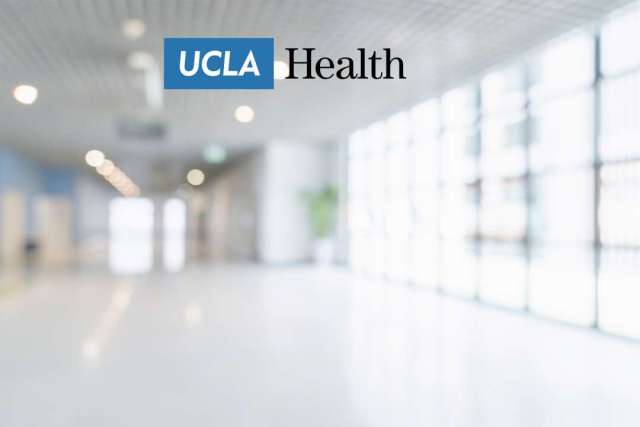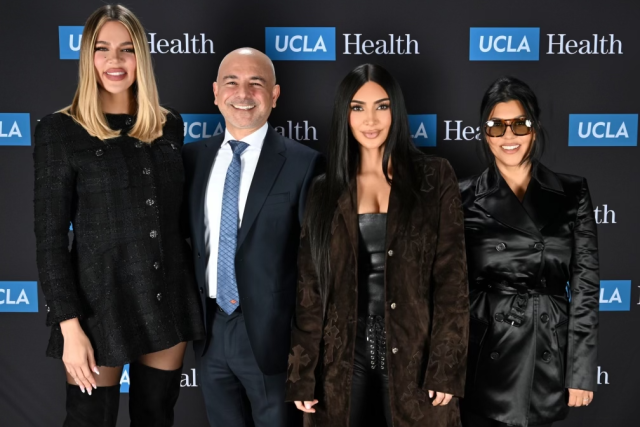Extending its reach in delivering the highest quality care long associated with UCLA, the UCLA Health, one of the most comprehensive and advanced health care systems in the world, dedicated its new Santa Monica campus Sept. 9 in a ceremony attended by doctors, nurses, university officials, and business and community leaders.
Part of a massive, systemwide rebuilding project, the new Santa Monica campus features the UCLA Health - Santa Monica Medical Center; a branch of UCLA Mattel Children's Hospital; the Los Angeles Orthopaedic Hospital; and the UCLA Rape Treatment Center. The new buildings, located at 16th Street and Wilshire Boulevard, will open for patient care in early 2012.
"We are proud to introduce another pillar of our world-class UCLA Health,'' said UCLA Chancellor Gene Block. "The Santa Monica campus provides a magnificent environment for healing, and it strengthens UCLA's capacity to offer the highest level of compassionate, state-of-the-art care to families in our local communities.''
The new campus complements the world-class services provided by the UCLA Health's existing facilities, including the Ronald Reagan UCLA Medical Center, the Stewart and Lynda Resnick Neuropsychiatric Hospital at UCLA, UCLA Mattel Children's Hospital, and more than 80 primary and specialty offices throughout greater Los Angeles.
Posie Carpenter, chief administrative officer of UCLA Health - Santa Monica Medical Center, said the new campus will provide the full continuum of services, from neonatal intensive care to geriatric medicine, in a welcoming yet technologically advanced facility.
"Our Santa Monica campus will be a jewel of the UCLA Health," she said. "Supported by the best doctors, nurses and hospital staff, this campus will help us improve overall patient care and bolster our continued growth into an academic medical center with long-standing community ties."
Key components of the new campus include:
- The Orthopaedic Hospital Institute, featuring an outpatient clinic for adult and pediatric orthopaedics, UCLA Department of Orthopaedics administrative and faculty offices, a library and museum-style display cases.
- 266 inpatient beds, most in private, spacious rooms that feature family space and sleeper chairs for rooming-in.
- A 22-bed adult and pediatric intensive care unit with the latest technology and 360-degree access to patients.
- Santa Monica's only inpatient pediatrics unit, a 26-bed facility.
- Integrated interventional and surgical services, including radiology and cardiac-catheterization labs, 16 state-of-the-art operating rooms and pre- and post-anesthesia care units.
- A conference center with meeting rooms and a 90-seat auditorium.
- A new cafeteria with indoor and outdoor seating.
Several key services opened during a previous phase, including the Nethercutt Emergency Center, in 2007, which now serves nearly 40,000 patients annually, and the BirthPlace, in 2008, with its comfortable, hotel-like labor, delivery and recovery rooms and a 16-bassinet neonatal intensive care unit.
Dr. David Feinberg, president of the UCLA Health and UCLA associate vice chancellor for health sciences, referenced the health system's mission of "healing humankind, one patient at a time" during his remarks at the dedication ceremony.
"Every patient who comes to us deserves the best, and every one of them, when they leave us, should be an ambassador to tell others about the great care and service they received at UCLA," he said. "This wonderful new facility not only accommodates scientific and technical excellence but also creates an environment that is healing."
The design of the hospital is inspired by the Northern Italianate architecture of the original buildings on the UCLA campus and by hospitality concepts that are reflected in the character of the building, its public spaces and patient rooms. More than 25 percent of the new campus is dedicated to green and open spaces.
"The new hospital is designed to create a comfortable, even home-like setting for delivering health care that will benefit patients, visitors and staff," said architect Robert A.M. Stern, who, along with CO Architects, designed the new building. "Additionally, we wanted to create a design that connected the Santa Monica campus with UCLA's Westwood campus to clearly establish its identity as part of the UCLA Health."
The rebuilding project was launched in response to damage caused by the 1994 Northridge earthquake. The new hospital was built to meet the latest seismic safety standards and can withstand an earthquake of up to magnitude 8.4, while redundant power sources will allow the hospital to operate for at least 100 hours following an earthquake without receiving any help from outside.
After patients have been safely moved to the new hospital in early 2012, the existing nine-story Tower building will be demolished to make way for additional landscaped gardens. A majority of the concrete and steel from the tower will be recaptured, ground up and recycled into new concrete and steel for future projects. Final site improvements should take about one year to complete.
Funding for the $572 million project was provided by multiple sources, including Federal Emergency Management Agency (FEMA) grants, bond initiatives, and donations from individuals and corporations.
A community celebration for the new campus will be held on Sunday, Sept. 18, from 1 to 4 p.m. Members of the public are invited for tours, health screenings, children's activities, musical entertainment, refreshments and giveaways. For event information, call 310-319-4471.
The UCLA Health has for more than half a century provided the best in health care and the latest in medical technology and research to the people of Los Angeles and the world. The UCLA Health is among the most comprehensive and advanced health systems in the world, comprising Ronald Reagan UCLA Medical Center; UCLA Health - Santa Monica Medical Center; the Resnick Neuropsychiatric Hospital at UCLA; UCLA Mattel Children's Hospital; and the UCLA Medical Group, with its wide-reaching system of primary care and specialty care offices throughout the region.
For more news, visit the UCLA Newsroom and follow us on Twitter.
Media Contact:
Ted Braun
Ted Braun



